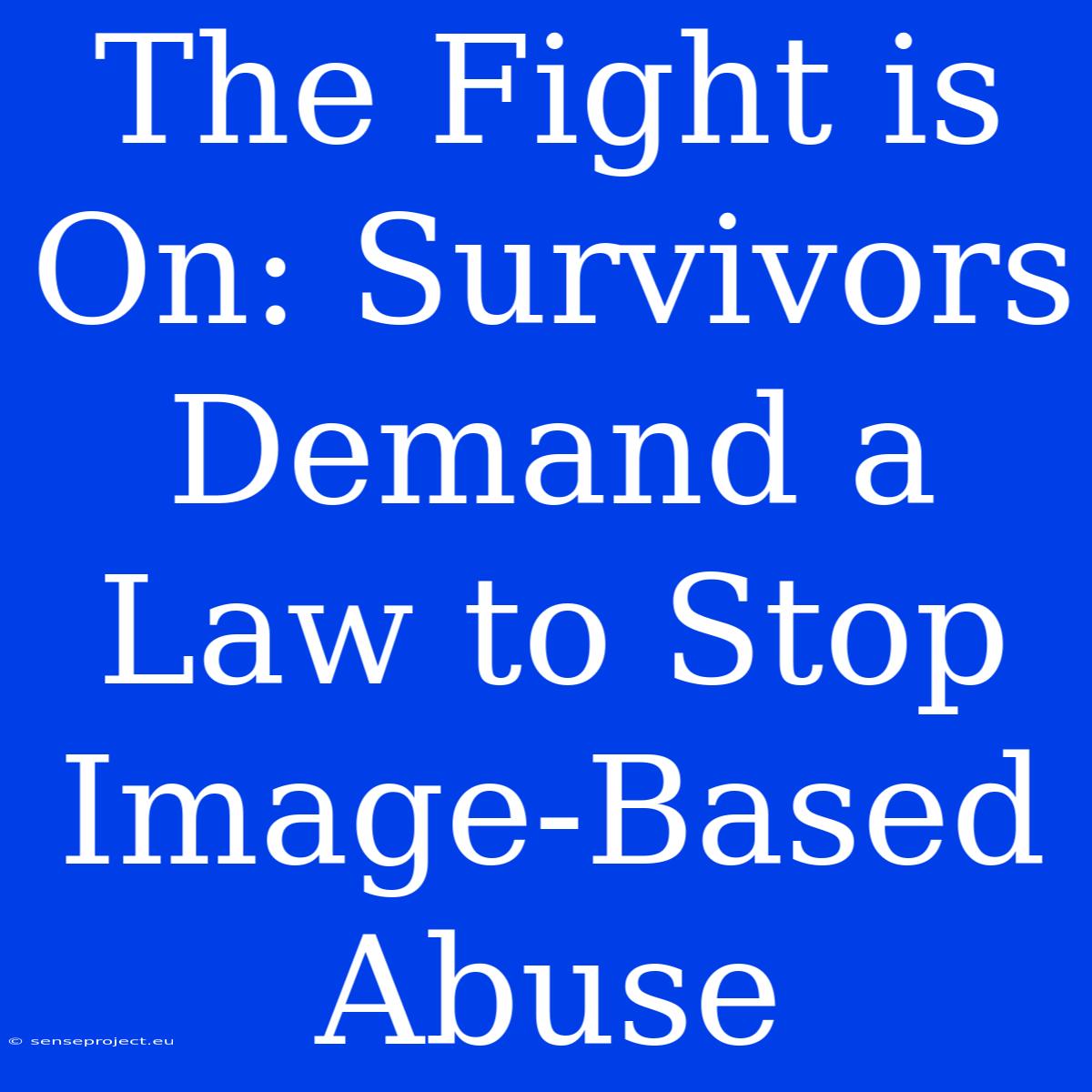The Fight is On: Survivors Demand a Law to Stop Image-Based Abuse
Can a law effectively combat the insidious spread of non-consensual intimate images? The answer is a resounding yes, and survivors are demanding a law to stop this form of abuse. Image-based abuse is a pervasive issue, leaving victims traumatized and vulnerable.
Editor Note: This article sheds light on the urgent need for legislation against image-based abuse.
This topic is critical because image-based abuse can have devastating consequences. Victims often face emotional distress, social isolation, reputational damage, and even physical threats. Furthermore, it perpetuates harmful gender norms and reinforces the power imbalance between perpetrators and victims.
Our analysis involved researching existing laws, examining the experiences of survivors, and consulting with experts in the field. We have compiled a comprehensive guide to understand the multifaceted nature of image-based abuse and the vital role legislation plays in protecting victims.
Key Takeaways:
| Aspect | Description |
|---|---|
| Prevalence | Image-based abuse is widespread and affects individuals across demographics and backgrounds. |
| Impact on Victims | Victims experience significant emotional, psychological, and social harm, often leading to fear, shame, and loss of self-esteem. |
| Legal Landscape | Existing laws are often inadequate, leaving victims with limited recourse and leaving perpetrators unaccountable. |
| Legislative Solutions | Proposed legislation aims to provide stronger protections, criminalize image-based abuse, and offer support to survivors. |
Image-Based Abuse: A Deeper Dive
Image-based abuse refers to the non-consensual sharing or distribution of intimate images without the victim's permission. It encompasses a wide range of behaviors, including:
- Sharing intimate images without consent: This includes sharing images taken without knowledge or permission, as well as sharing images from past relationships without consent.
- Threatening to share intimate images: This constitutes emotional abuse and manipulation, often used to control or coerce victims.
- Posting intimate images online without consent: This can lead to public humiliation, reputational damage, and online harassment.
The Need for Legislation: A Beacon of Hope
The lack of comprehensive laws has historically left survivors vulnerable. Legislation plays a critical role in:
- Criminalizing Image-Based Abuse: Establishing clear legal definitions and penalties for image-based abuse sends a strong message that such behavior is unacceptable.
- Providing Support to Victims: Laws can provide resources for victims, such as access to counseling, legal aid, and victim support services.
- Deterring Future Abuse: By holding perpetrators accountable, legislation can discourage future instances of image-based abuse and create a safer online environment.
The Impact of Existing Laws
Existing laws are often inadequate, leaving victims with limited recourse and leaving perpetrators unaccountable. Some challenges include:
- Limited Scope: Existing laws may not cover all forms of image-based abuse, such as the sharing of images without consent, but with the victim's knowledge.
- Lack of Enforcement: Laws may exist but lack effective enforcement mechanisms, making it difficult to hold perpetrators accountable.
- Focus on Revenge Porn: Existing laws often focus on revenge porn, neglecting other forms of image-based abuse.
Emerging Solutions: A New Era of Protection
New legislation is emerging to address the complexities of image-based abuse. Key features include:
- Expanded Definitions: Laws are being broadened to encompass a wider range of behaviors, including the sharing of images without explicit consent.
- Stronger Penalties: Increased penalties and mandatory reporting requirements aim to deter perpetrators and ensure accountability.
- Victims' Rights: Laws are being designed to provide victims with greater access to support, legal representation, and redress.
FAQs: Unveiling the Truths
FAQ:
| Question | Answer |
|---|---|
| What are the signs of image-based abuse? | Victims may exhibit emotional distress, social withdrawal, fear of technology, or changes in behavior. |
| What can I do if I'm a victim of image-based abuse? | Contact a trusted friend, family member, or professional for support. Document the abuse and report it to the relevant authorities. Seek legal advice to understand your options. |
| What are the benefits of enacting stronger laws against image-based abuse? | Stronger laws provide victims with greater protection, ensure accountability for perpetrators, deter future abuse, and create a safer online environment. |
| How can I contribute to the fight against image-based abuse? | Educate yourself and others about the issue, raise awareness, support organizations working to combat image-based abuse, and advocate for stronger legislation. |
| What are the challenges in enforcing laws against image-based abuse? | Enforcing these laws can be challenging due to the anonymous nature of the internet, cross-border issues, and difficulties in identifying perpetrators. |
| What are the long-term consequences of image-based abuse? | Long-term consequences can include PTSD, depression, anxiety, social isolation, and difficulty forming healthy relationships. |
Tips for Staying Safe Online: A Guide to Prevention
Tips:
- Be mindful of the content you share online. Avoid sharing intimate images with anyone you don't fully trust.
- Use strong passwords and privacy settings. Protect your online accounts and limit access to sensitive information.
- Be aware of your surroundings. Avoid taking intimate images in public places where they could be easily captured by others.
- Keep a record of all communication. This can be helpful in case of future disputes.
- Report any suspected instances of image-based abuse. Contact the appropriate authorities or online platforms to report abuse and seek support.
Summary: Embracing a Safer Digital Future
This article has explored the urgent need for legislation against image-based abuse. Survivors are demanding a law that acknowledges the severity of this form of abuse, providing victims with the support and protection they deserve.
Closing Message: By recognizing the impact of image-based abuse, understanding the need for strong legal frameworks, and promoting online safety, we can collectively contribute to a more secure and equitable digital environment for all.

